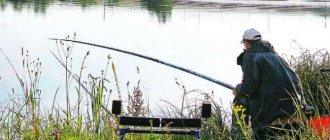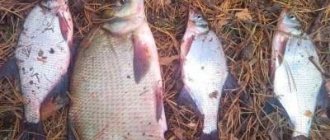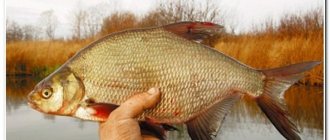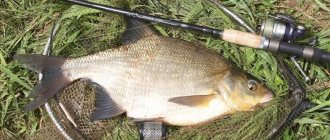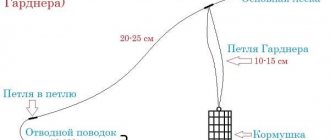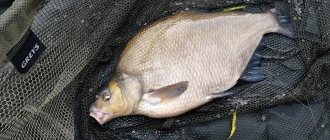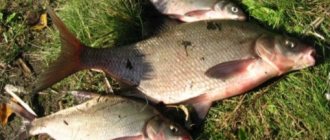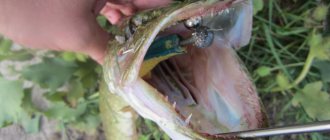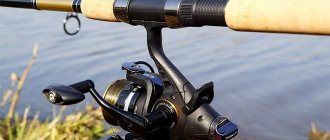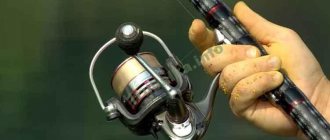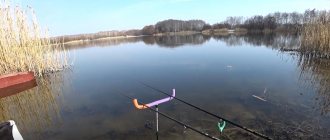Spring habits of bream
The hunt for bream begins in early spring, as soon as the snow melts. The frequency of bites will only increase as the reservoir warms up; fishing at temperatures of +12–14 °C will be promising.
When the temperature is above +15 °C, you should not expect activity from the bream; it begins to spawn. The spawning period lasts 4–6 days in consistently warm weather of 16–17 °C. At the end of this phase, the angler again has the opportunity to catch bream, but only near the coastal zone. The peak of activity is zhor, which lasts almost a week, then you need to look for the trophy in the pits, where it spends the entire warm season.
The correct choice of place for fishing allows you to remain with your catch in any situation. This is a good time to fish:
- Areas with rocky or clay bottom. The working depth is from 1-2 m.
- Shell shoals.
- Places remote from the coast.
- Shallow water areas near riverbeds and pits. Fishing for bream in the spring on a feeder in calm weather, as well as during a breaking wave, turns out to be especially successful.
Having arrived at the reservoir, familiarize yourself with the bottom topography and determine where there are snags, stones and depth changes. Catching bream on a feeder is in a quiet and deserted place with warm water.
Large specimens can often be caught in areas with a sandy bottom, where the depth is half a meter. When fishing in rivers, promising places will be areas near oxbow lakes, old riverbeds, and steep cliffs.
To find a bream place, you should watch the water surface. The presence of splashes and circles on it makes it possible to identify promising places for hunting.
Habitats and habits
The main habitat of bream is deep reservoirs, rivers and lakes. Bream is a schooling fish, although large individuals accompany the schools rather than being their full members. The size of the flock is not significant and the number of individuals in the flock increases in the fall before laying down for the winter. Bream overwinters in deep holes at depths of up to 12 meters, and with the onset of spring it moves to shallower places, with a depth of up to 2 meters.
Bream is a fish that actively migrates through a reservoir, but does not carry out long migrations, with the exception of spawning migration. Throughout the day, bream visits the same territories several times, as if patrolling their domain. It is impossible to predict the routes of such migrations, and fishermen who want to catch a dozen “bream” have to rely only on the bottom topography where the fish most often feed. Such “generally recognized” feeding places are deep sections of rivers and lakes with channel edges, ditches and depressions, and sections of a reservoir near steep banks. Bream does not ignore quiet pools not covered with dense thickets of aquatic vegetation. A very important characteristic of the above-mentioned places is the presence of a clayey or sandy-silty, hard bottom and the absence of a strong current.
To confirm my words, I will allow myself a small quote from the book by L.P. Sabaneev “Life and Catching of Freshwater Fish”:
“Place of fishing. By the very shape of its body, bream should avoid fast currents and, on the contrary, stick to calm waters. In addition, caution forces him to choose deep places for his permanent residence, more or less inaccessible to seines, and therefore the distribution of bream is quite sporadic, that is, it may not be found at all over a significant area of the river. Bream do not like places with a flat sandy bottom and only come here as a passage: they are both hungry and unsafe here. Nevertheless, they may like rivers with a rocky bed, which are always almost very fast. Thus, there are many rivers, even navigable ones, where they are rare, and, conversely, there are rivers that can be called bream rivers. For the most part, the latter are characterized by a hard sandy, slightly silty or clayey bed; such a bottom contributes to the formation of deep holes at turns, under holes, and ledges, that is, it gives bream protection both from the current and, most importantly, from the seine.”
Bream feeds on all kinds of crustaceans, mollusks, worms, and insect larvae living in the bottom layer of soil. Sometimes it supplements its diet with the remains of plants that it finds at the bottom. Adult bream can become bloodthirsty - eating eggs and juveniles of other fish, becoming like predators.
The bream school spends almost all its time in the bottom layers of water. In warm, calm weather, more often before sunrise and before sunset, it can rise to the surface of the water, but during such ascents it does not show much appetite.
A distinctive feature of bream is its caution, which can often be seen when biting. A barely noticeable trembling of the feeder tip and small jolts into it indicate that the fish has taken the bait into its mouth, but is in no hurry to swallow it. Doubts of inexperienced fishermen with a nervous grip on the rod, and then an abrupt stop in their movement - “hook or wait”, an incorrectly selected hook (not capable of self-hooking the fish) often become the reason for the departure of not only an individual fish, but also the entire school.
It is worth mentioning the widespread opinion among “experienced” fish that bream is capable of signaling danger to its fellow fish through the mucus it secretes. Therefore, as the “experienced” advise, after each caught bream you need to change the bait on the hook and rinse the feeder in water so that “God forbid you don’t scare off” other bream with mucus residue. Whether this is true or a whim is up to the reader to decide. Personally, I think this is a misconception and a beautiful story for a word.
Selection of gear and preparation of equipment
For successful feeder fishing choose:
- a medium or heavy class rod, everything will depend on the strength of the current;
- when fishing at a distance of 60, use models with a length of 3.9-4.2 m;
- for hunting in the coastal zone, a feeder 3.6 m long is used, a picker – 3.3 m;
- For catching bream at medium and close distances, a slow action tool, a semi-parabolic, is suitable. Their advantage lies in the effective development of powerful jerks of fish;
- Any top will be relevant. Rigid quivertips work great in windy weather.
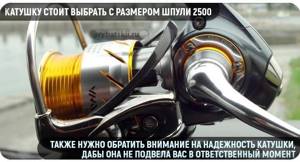
You should take a reliable reel, size 2500. It is better to use models for bream designed for forcefully fishing for prey. It is necessary that the main pair, gears, bearings be adapted for serious loads. When fishing in medium or strong currents using feeders from 100 grams, lightweight models can fail, they simply cannot cope, they fail at the wrong moment.
For the main line, you should choose a thread with a thickness of 0.22-0.25 mm if fishing is carried out near the shore. If the promising location is located at a distance of 50 m from the shore, then give preference to wicker with a thickness of 0.12-0.14 mm, a breaking load of 5-6 kg.
Place a medium-sized feeder for fishing in early spring, and large ones closer to summer. When fishing in areas with a hard bottom and at long distances, a bullet feeder with a plastic body is suitable.

Of the installations, the priority will be an asymmetrical loop; inline and paternoster are also suitable. When fishing with a feeder in the spring, the main thing is not to use too many fasteners, swivels, and other elements. The advantage of the paternoster is that it is knitted on the main line. When using a braided cord, it is better to knit a paternoster loop into a loop from a thread with a cross-section of 0.3-0.35 mm, where a feeder is threaded into the large one, and a leash into the small one. For the leash, use high-quality fishing line such as Owner, Climax. In most cases, a leash length of 25 cm is enough, the thickness of the fishing line is 0.12-0.18 mm.
If you plan to hunt for bream on a shell, then fluorocarbon fishing line and hard monofilament are suitable.
Hooks made of thin wire with No. 10–12. For fishing in the middle and end of spring, use a hook No. 8–10 with bait of several worms and peas, grains of canned corn.
Fishing tactics and equipment features
The most effective tackle for catching bream during this period, undoubtedly, remains a feeder. The feeder allows you to cast to the required distance and place a portion of bait close to the hook with bait, which in itself is an attractive factor. When choosing a feeder, it is very important to pay attention to the fact that after lowering to the bottom, it lies motionless and does not succumb to displacement under the flow of water, otherwise its “dance” will scare away the wary bream.
Often, fishermen, trying to get rid of the “dancing” of the feeder, make various modifications: this is an increase in the weight of the feeder by mounting “Cheburashkas” in its basket, which are used in spinning fishing; equipment on the sides of the feeder - wire mustaches or arcs with which the feeder will cling to the ground, etc. Although in fairness, I note that nowadays it is not so difficult to choose a feeder feeder of the required weight and shape (with a rectangular, triangular or teardrop-shaped cross-section) in a fishing store. Paying attention to the shape, remember that the most stable feeders are those in which the lead is mounted on the entire plane of the “sole”, and not in a narrow strip in its center. In addition, feeder feeders, in which the width of the “sole” is greater than the height itself, are the most resistant to tipping over.
Speaking about the equipment itself, it’s a matter of taste – a “paternoster”, a symmetrical loop or a “helicopter”. The only limitation can be the use of an anti-twist tube, as it can tremble, echoing the fluctuations of the water masses. But again, this is my opinion and I will not deny that I have seen quite effective bream fishing with such equipment. I myself fish with an asymmetrical loop and confidently consider such equipment to be the “only suitable” one for this matter.
Leashes for catching bream should be long, from 0.7 to 1 meter. Having straightened out in the current, he will remove the hook with bait from the rig, and thus all its movements when carefully tightening the line at the moment of biting will be hidden from the eyes of the bream, which gives the fisherman a head start in time for a successful and timely hook.
The most “tasty” bait for bream will be a worm, maggot, or bloodworm because they contain a large amount of protein, which the fish needs in the spring. It’s a good idea to experiment with “sandwiches”, combining both plant and animal components for the bait.
It would not be fair to ignore the topic of bait, since without it, catching bream would be more an accident than a pattern. It is necessary to feed the bream, but remember that in the spring the fish do not need a lot of food. Remember also that the bait should be localized as much as possible at the bottom, and have increased inertness and viscosity.
Don’t try to base your fishing tactics solely on the fact that bream will come to the bait you provide. You need to start from knowledge of the reservoir, its bottom characteristics and feeding places for schools of bream. If your knowledge in this area is not significant, then at least try to find evidence that bream actually feeds in one place or another. Visual signs of the presence of bream may be: clouds of turbidity rising from the bottom; pop-up air bubbles; slight disturbances of water on the surface from the passage of fish.
And finally
Groundbait recipes
To make the bait mixture you will need:
- for the base - bran, oatmeal, cookies, dried bread;
- for nutritional value - maggots, finely chopped worms (steamed cereals - closer to summer);
- as a binding element - semolina, flour, oatmeal, any other ingredient with increased stickiness;
- for aroma – roasted flax seeds, dill, coriander, hemp oil;
- for coloring the composition - construction soot.
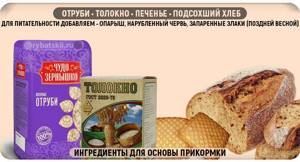
To ensure that complementary foods have a dusting effect, use powdered milk and a couple of tablespoons of condensed milk.
The bait mixture can be purchased ready-made in a specialized store, or made at home. To create a universal composition for bream you will need the following components:
- breadcrumbs (1 kg);
- sugar cookies (200 g);
- cooked millet (300 g);
- corn flour (100 g);
- caraway;
- wheat bran (200 g);
- Hercules (30 g).
- sugar (2 tbsp);
- maggot.
Grind all ingredients, except maggots, and mix. Add water directly at the fishing spot. The finished bait mixture should not break, but stick together well. It is placed in a feeder or used to form balls that are thrown into the fishing point manually. Such a nutritional composition will soon collect bream in the working area.
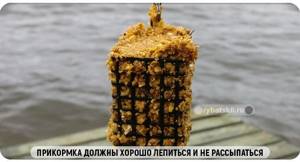
Another recipe for baiting bream in the spring:
- bread crumbs (600 g);
- ground roasted seeds (100 g);
- wheat bran (200 g);
- ground grains of boiled corn (200 g);
- rolled oats (30 g);
- powdered milk (1 package);
- bloodworms or maggots (3 matchboxes).
The algorithm for preparing bait is the same as in the previous case.
When and what flavors to use
In cool water (up to +15 °C), you should not add flavorings to the bait composition. A little later, towards the end of spring, liquid formulations with the smell of bloodworms and worms will work.

Among the flavorings suitable for catching bream in spring are:
- peanut;
- dill;
- caraway;
- garlic;
- coriander;
- blood;
- banana;
- Tutti Frutti;
- strawberries;
- honey;
- gingerbread
Nozzles depending on fishing conditions
For fishing in early spring, choose bloodworms and place not one, but 2-3 on the hook. To enhance the effectiveness of such a nozzle, maggot or a fragment of a worm is used as a supplement.
If you catch bream in muddy water, then you need to equip the hook with a foam ball in addition to bloodworms. Scalded or pupated maggots are also suitable. The larva, which has turned into a pupa, has a hard skin and a soft inside. When it finds itself in the water, it stays afloat and does not sink, which attracts the attention of the fish.
In the spring, it is good to use high-calorie and protein foods as bait for bream. The warmer the weather becomes, the more efficiently a bunch of maggots, bloodworms, and worms works. It will be relevant at this time to use leeches and shell meat.
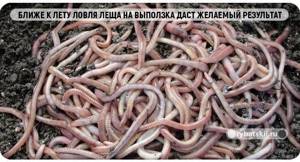
Closer to summer, when the water and air are warmed up and the bream begins to bite better, crawls are used. The use of vegetable attachments will also give results, especially pea grains with sugar and honey. Not only whole peas can attract bream, but also mastyrka from it. In late spring, the effect will also be from using canned corn, barley, and star pasta.
☸ Where to catch
The behavior of bream in the spring cannot be called typical. At any other time of the year, he strives for greater depths, but in the spring, food and warmth are more important to him. In stagnant lake water, this fish is dispersed over the entire area approximately equally. The highest concentration is observed in places with an uneven bottom, near islands of dry last year's reeds, in the coastal zone, if depth allows. Here the search will not take much time.
It is much more difficult to look for bream on the river. The usual bream points do not work in the spring; he will return to them closer to summer, when the water warms up well. Therefore, experienced feeders advise starting your search from the nearest riverbed edges, where the chances of catching spring bream are quite high. After leaving the wintering hole, this fish moves closer to the shore, sometimes even appearing in shallow water. This choice is explained simply: it is warmer here and there is food washed into the river by flood waters.
When fishing in unfamiliar bodies of water, beginners often make the same mistake - throwing gear at random. But the bottom surface in the chosen place may turn out to be smooth as a board, and bream never lingers in such areas. To begin with, you should probe the bottom, find at least some irregularities. Finding a suitable edge will not be difficult. To do this, you can use a special marker weight or throw an empty feeder and pull it along the bottom. Where it meets a little resistance is most likely the edge. Now all that remains is to feed the point and you can start fishing.
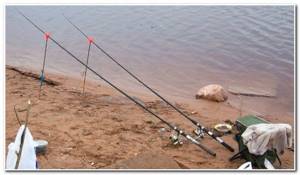
Some fishing features
To ensure that your fishing trip in the spring is not unsuccessful, follow the recommendations:
- Before starting fishing, study the bottom topography at the selected point of the reservoir.
- Experiment with attachments.
- If the bite is bad, pierce the maggot or worm in several places, this will help to awaken the fish’s appetite.
- In the spring, don’t expect powerful bites; you need to keep an eye on the rod tip.
- Do the cutting whenever the signaling device moves.
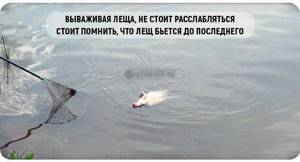
Anyone can catch bream on a feeder in the spring if they choose the right place and know some of the subtleties of this process. Pay attention to fighting, this opponent is capable of resisting to the last, moving to the side. Bream is a cautious and neat fish, so excessive fuss can scare it away.
Baits and baits for bream in spring
In terms of attachments and lures, everything is pretty standard. Only adjusted for the fact that the feeder equipment is delicate, the bream is not active enough in the spring, and the hooks are not huge.
Animal baits include:
- Bloodworm. Not in a bunch, from one piece to 5. In a ring, piercing through the middle, or over the edge. We test it on a pond.
- Maggot. From 1 to 3 pieces. White Red. Their combinations.
- Small worm. Dung, earthen. You can try halves of worms.
- Various combos. Sandwiches. Maggot + bloodworm, maggot + worm and so on..
Plant attachments can work even in early spring:
- Barley with snot. From 1 to 2 grains.
- Semolina mash. With increased viscosity and only during intensive fishing. Doesn't hold well on the hook, knocks down small things. But when a school of bream approaches a point, you don’t have to worry about bites from small fish.
- Corn. The grains are not large. From 1 to 2 pieces.
Starting fishing with “sandwiches” is not recommended. You may not understand the preference of bream at the moment.
